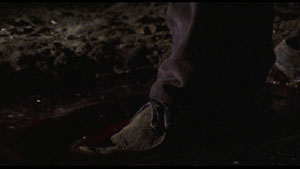A Brief Overview of Aspect Ratios
- 1.33:1 (4:3) - The original shape in which movies were shown, thus the shape that was adopted by Televisions.
- 1.78:1 (16:9) - This is now the shape of digital TVs.
- 1.85:1 - The narrower of the two common shapes for films today.
- 2.35:1 - The wider of the two common shapes for films today.
- Pan & Scan - When a film that is in 1.85:1 or 2.35:1 is cropped to fit a 4:3 frame. Butchery. Destroying the Director's intended vision and robbing the viewer.
- Widescreen - A general term for any aspect ratio that is wider than the 1.33:1 aspect.
- Fullscreen - When a film that is shot in and framed for the 1.33:1 aspect and is presented as such. Fullscreen is good. It is a preservation of an original aspect ratio.
- Matted Widescreen - When black bars are put on top and bottom of the screen to create a widescreen aspect. If it's used to mask a film that was intened for 1.33:1, it is just as criminal as Pan & Scan...
The Evil Dead
 |
 |
| Fullscreen = Good | Matted Widescreen = Bad See how the top and bottom of the frame is matted out? You don't even see the Band-Aids in the pool of blood joke! |
Halloween
 |
 |
| 2.35:1 Widescreen = Good | Pan & Scan = Bad Look at how much of the image is cropped from the frame. |
 to Dark Lord's Domain.
to Dark Lord's Domain.
 "Dark Lord" Paul Lenkic
"Dark Lord" Paul Lenkic
"Accept the Lord of Darkness as your saviour!" - The Undertaker
© 2002